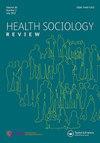理解堕胎药:加拿大RU486的社会技术分析
IF 2.5
2区 医学
Q2 HEALTH POLICY & SERVICES
引用次数: 2
摘要
摘要2017年1月,“堕胎药”终于在加拿大合法使用。本文对加拿大围绕RU486的争议进行了社会技术分析,重点是它在1990-1995年进入公共话语。该案例研究主要借鉴了加拿大媒体和各演员的平面传播中关于该药丸的声明。利用科学和技术研究的方法,该分析确定了多个人类和非人类行为者,他们对RU486和彼此的话语动员,以及他们的偶然联盟,说明了RU486如何调解和塑造试图定义它的沟通。解开网络的复杂性,可以看出这些有意义的做法是如何建立起该技术道路的早期设置的,这是理解为什么加拿大在提供药丸方面一直落后的第一步。讨论说明了网络中阻碍RU486从发展到扩散的紧张、不稳定和逆转。最后,本文提出了一个未来社会学研究框架,以研究有争议的生殖技术从话语转向物质传播,承认女性作为用户的整体作用。本文章由计算机程序翻译,如有差异,请以英文原文为准。
Making sense of the abortion pill: a sociotechnical analysis of RU486 in Canada
ABSTRACT In January 2017, the ‘abortion pill’ was finally used legally in Canada. This paper provides a sociotechnical analysis of the controversy surrounding RU486 in Canada, focusing on its entry into public discourse, 1990–1995. The case study draws primarily on statements made about the pill, both in Canadian media and in various actors’ print communications. Using approaches from science and technology studies, the analysis identifies the multiple human and nonhuman actors, their discursive mobilizations of RU486 and each other, and their contingent alliances, illustrating how RU486 mediates and shapes the communication that attempts to define it. Unpacking the network's complexity illuminates how these sense-making practices established the early setting of the technology's path, a first step in understanding why Canada has been a laggard in making the pill available. The discussion illustrates the tensions, instabilities, and reversals in the network that have hindered RU486′s movement from development to diffusion. Finally, the paper suggests a framework for future sociological research on controversial reproductive technologies in their shift from discursive to material diffusion, one that recognises the integral role of women as users.
求助全文
通过发布文献求助,成功后即可免费获取论文全文。
去求助
来源期刊

Health Sociology Review
Multiple-
CiteScore
7.50
自引率
0.00%
发文量
14
期刊介绍:
An international, scholarly peer-reviewed journal, Health Sociology Review explores the contribution of sociology and sociological research methods to understanding health and illness; to health policy, promotion and practice; and to equity, social justice, social policy and social work. Health Sociology Review is published in association with The Australian Sociological Association (TASA) under the editorship of Eileen Willis. Health Sociology Review publishes original theoretical and research articles, literature reviews, special issues, symposia, commentaries and book reviews.
 求助内容:
求助内容: 应助结果提醒方式:
应助结果提醒方式:


